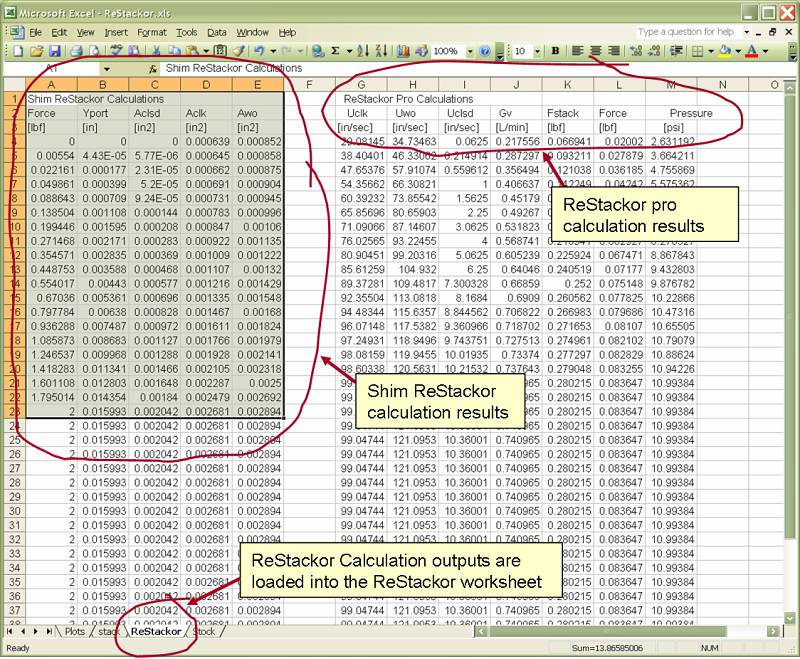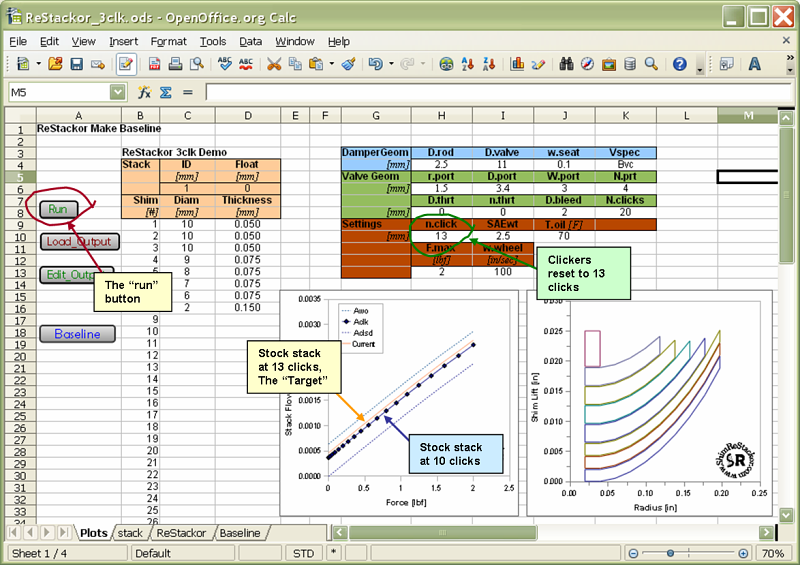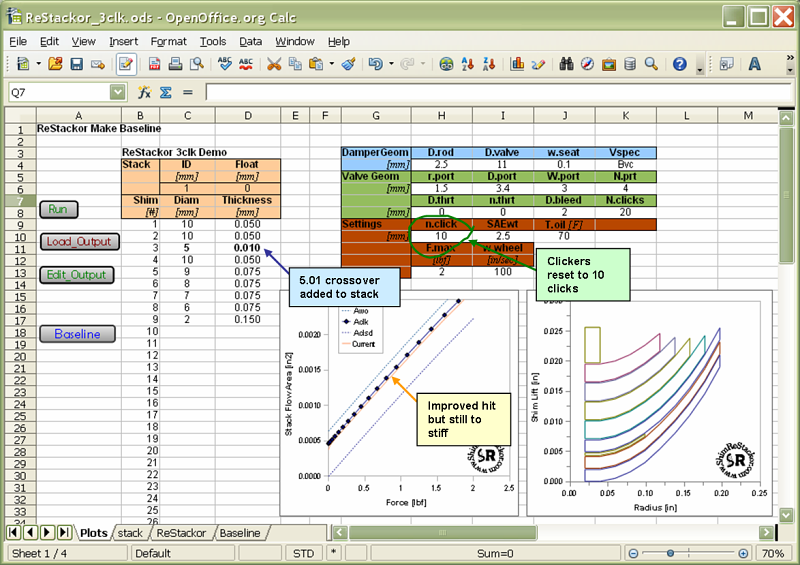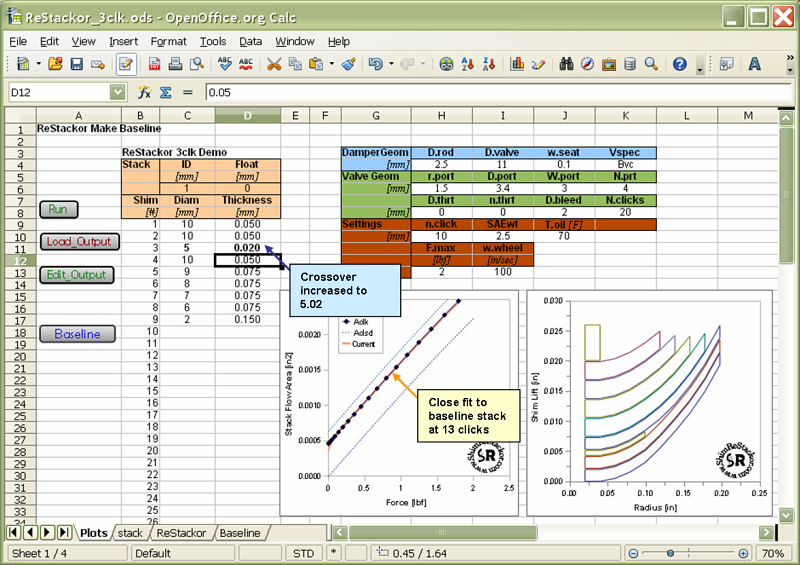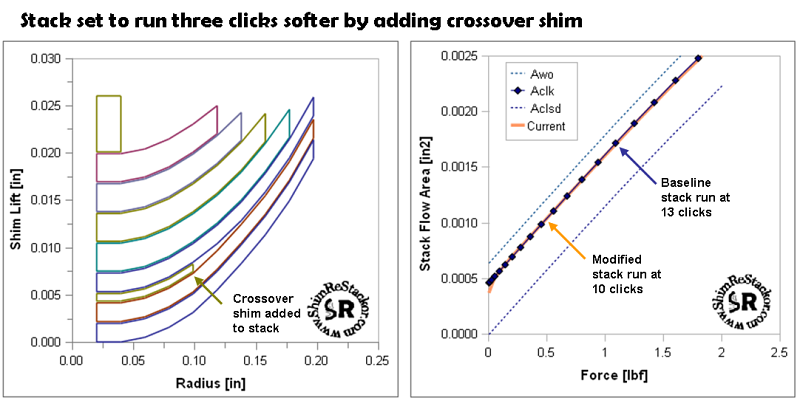

Tuning Basics
Sample Applications

ReStackor Sample Applications
Finally computer software to tune a shim stack
Set A Shim Stack to be Three Clicks Softer
This Shim ReStactkor example retunes a stack to be three clicks softer across the entire range using the demo version of Shim ReStackor. If you have downloaded the demo you can follow along and develop your own stack. The demo version is limited to shim diameters of 10 mm and stacks with less than ten shims.
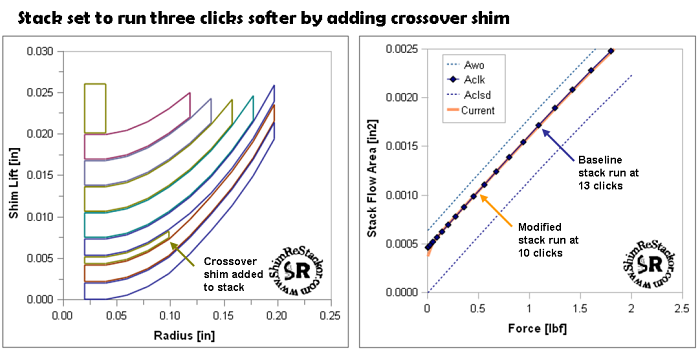
Shim ReStackor calculations used to add a crossover shim to make the shim stack three clicks softer
The "stock" stack for this demo is a simple tapered stack with 7 shims and a 2mm clamp at the top of the stack. The valve diameter is set to 11 mm with a 2 mm bleed and a 20 click adjuster. The first calculation is for the stock stack with the clickers "centered" in the 10 click position. To run the case all you have to do is click the "Run" button and you well see an execution window pop up execute the 11,000 lines of ReStackor code. With current computer speeds that only takes a couple of seconds.
After the run completes the ReStackor outputs are loaded into the spreadsheet by clicking on the "Load_Output" button. This loads the calculation output data into the "stack" and "ReStackor" tabs of the spreadsheet. All of the plots automatically update.
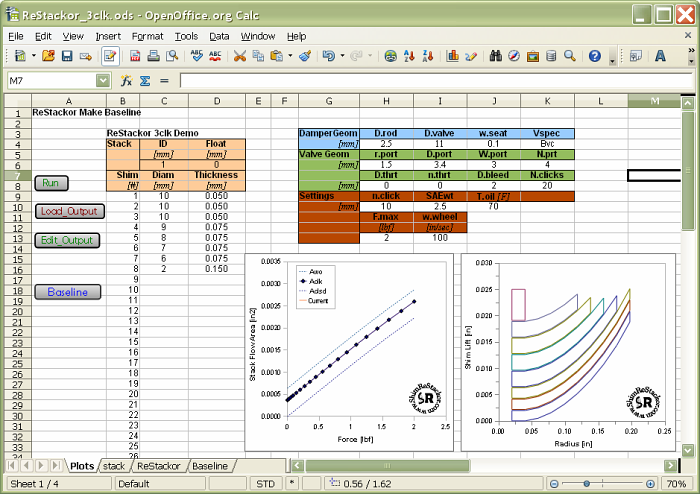
You also need to click the "Baseline" button. This copies the results of the current output in the ReStackor tab to the Baseline tab of the spreadsheet. The Baseline button allows you to easily compare results from different calculations.
![]()
Saving the stock stack stiffness curve for comparison with other stacks
Whenever you click the load output button the current ReStackor output files are loaded into the spreadsheet and any existing data in the "stack" and "ReStackor" worksheets are overwritten. If you want to see the numbers they are in those sheets.
![]()
Target stiffness of New Stack
This example attempts to make the shim stack 3 clicks softer. To set that target set n.clicks in cell H10 to 13 and click the Run and Load_Output button. The difference between the baseline case (saved above for the 10 click calculation) and the orange line is the change needed.
Since our target is the 13 click case click on the Baseline button to transfer the current calculation results of the orange line to the baseline tab.
The next step is to reset the clickers to the 10 click position and determine the stack modifications needed to make the stack at 10 clicks follow the 13 click curve.
Here, you could attempt to apply the typical shim stack rules of thumb: stack stiffness varies with the diameter squared and the thickness cubed; and try and trig out a stack modification. But, with the spreadsheet it is much easier to hack, guess and try different stack configurations until you find something that has the stiffness you are looking for.
![]()
Crossover Shim
To soften the low speed damping we are going to need a crossover. Putting in a 5.01 shim shows the stack moving in the right direction but not far enough to match the 13 click curve.
![]()
Matching High Speed Stack Stiffness
Increasing the crossover thickness to 0.02 produces a very close match to the 13 click curve. You could try and further improve that curve by moving the crossover up or down one shim to see if it provides a better damping profile.
![]()
ReStackor Clicker Map Simplifies the Tuning Process
Retuning a stack with Shim ReStackor is a simple process. With a couple of calculations you can produce a clicker map for the stock stack and plot all stack modifications relative to the clicker map. This allows you to instantly evaluate stack modifications in terms of clicker settings. If you are looking for a three click softer setting you can immediately dismiss configurations that produce stiffer stacks. This simple step will save you a huge amount of time in suspension tuning by preventing you from wasting your time installing and testing stacks that are outside the range damping force you want.
Stack Parameters can be Designed to Produce Specific Effects
For the example above the stack was made three clicks softer by adding a crossover shim. Without some good calculation capability adding a crossover shim to a stack can be difficult. You have to decide how many shims should be in front of the crossover what shim diameter to use and what thickness the crossover should be. With ReStackor you can easily evaluate crossover configurations and pick the shim diameter and position that gives you the clicker setting you were looking for.
Without ReStackor you would have to guess at the crossover shim position, thickness and diameter; install the stack and test. Going through several configurations would take days, if not months.
With Shim ReStackor you can retune the stack in several minutes, design the stack to have the stiffness you want and evaluate the stack performance across the entire range of operation. ReStackor removes the guess work out of shim stack design and allows you to confidently modify the stack configuration to obtain the stiffness you want.
In the past tuners have attempted to directly use the Belleville washer equations to estimate stack stiffness and scale the stiffness of the stack up or down by some percentage. There is no direct way to handle crossover shims with this approach, in addition stack stiffness alone does not account for the subtle effects of stack taper and its effect on the bend profile and flow area produced by deflection of the face shim. The stack force balance in Shim ReStackor accurately determines the face shim bend profile and integrates the flow area along the edge and side of the valve port to directly determine the flow area and references that flow area to the bleed circuit clicker settings. The capability to compare stack modifications to the clicker settings gives you and instant real world reference to the stiffness of the stack and helps to keep you from wasting your time installing and testing stack that are way outside the stiffness range of interest.
ReStackor allows you to fine tune your suspension far beyond levels previously possible
After installing and testing riding the bike you may find the modifications you thought you wanted were not what you needed. Here, ReStackor can help you retune the stack to something midway between the stock stack and the new stack or further modify the stack to something stiffer if that is what you determined you needed. The capability to design the stack and control the stack stiffness across the range of operation is a huge improvement in your capability to tune a stack.

